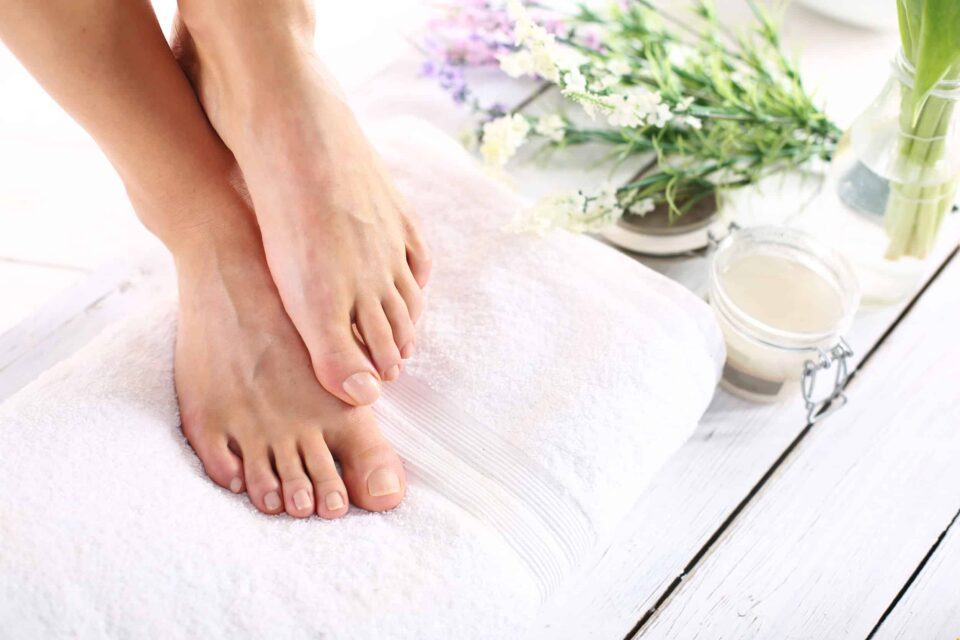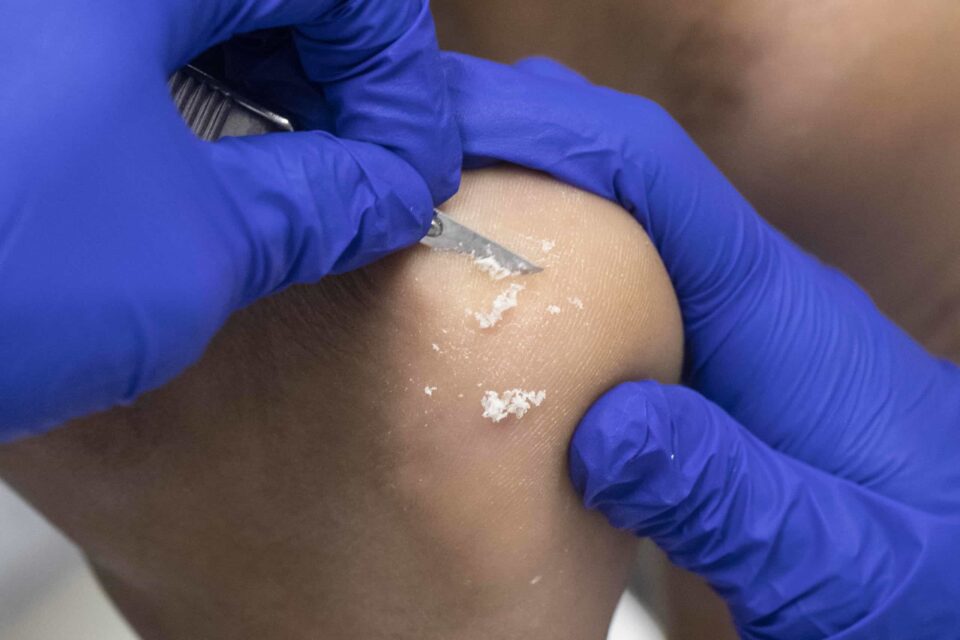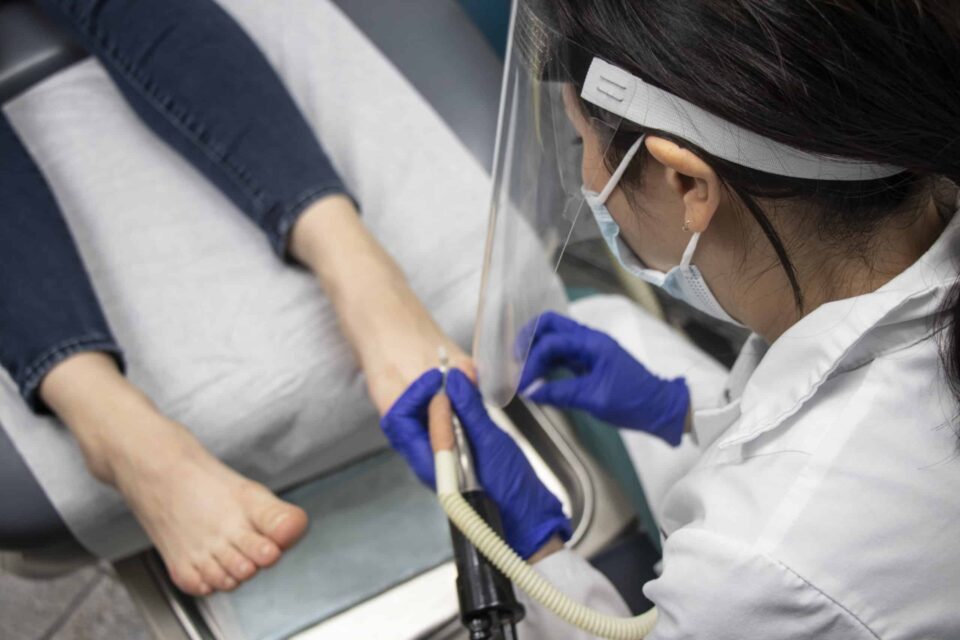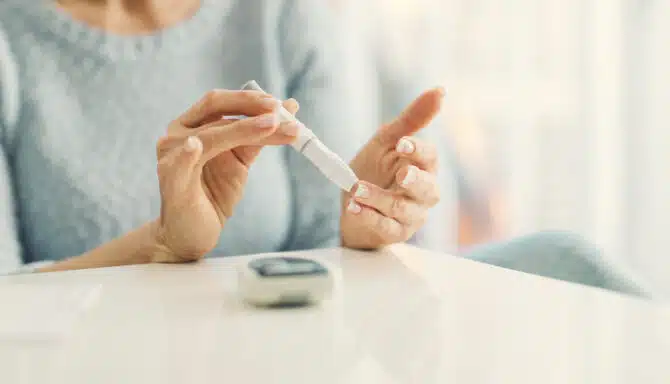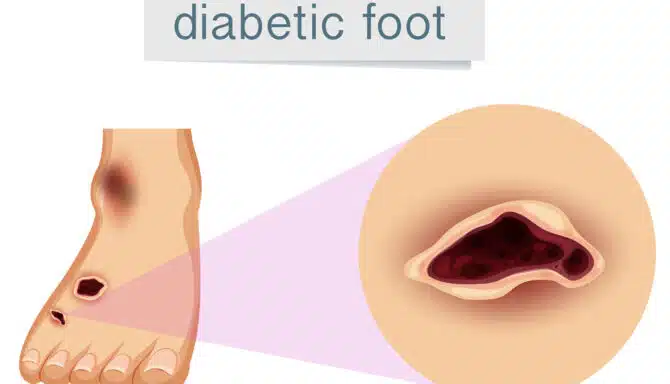October 14, 2024
There are many at-home and natural remedies for foot pain that work, but there’s no denying the importance of foot exams with a top Toronto chiropodist. Some conditions require foot check-ups throughout the year and your foot clinic visits can make a big difference in not only your comfort levels, but your long-term health. Let’s take at what you can expect at a foot clinic appointment and why you should get your check-ups.
What You Can Expect at a Foot Clinic
This depends on if you’re visiting your foot clinic for the first time or are following up with a specific service, such as a custom orthotic casting and fitting or a medical pedicure.
At Toronto’s Feet First Clinic, your first foot check-up—an initial foot assessment—helps determine your unique needs. It’s your chance to discuss any concerns so your chiropodist can tailor the care to what matters most to you. Many people schedule one if they have persistent foot pain, but you may also do it for diagnostic purposes, footwear recommendations and more.
Why Schedule Regular Foot Check-ups?
Regular foot care is mandatory if you have diabetes. Studies show that neglecting your feet and failing to visit your foot specialist may lead to infections, ulceration and limb loss. While they sound extreme and scary, chiropody services can help you prevent these problems.
Chiropodist visits for diabetes include full examinations (particularly to assess for neuropathy), nail and skin care, wound debridement, and more. Some experts recommend coming in every 4-6 months, but this may be more or less, depending on your condition.
Foot check-ups are also a must for anyone with arthritis, circulatory issues, a history of strain injuries like plantar fasciitis, chronic fungal infections, to name a few. They’re especially important as we get older. But really, anyone can benefit from a little foot TLC—whether you're on your feet all day or just looking to prevent future problems, regular check-ups help keep your feet healthy, pain-free, and ready to go wherever life takes you!
An annual foot assessment is also a great preventative form of self care, like a wellness check for your feet. You don’t have to wait until you notice symptoms — assessments can catch early signs of the most common foot issues before they become painful.
August 19, 2024
Foot care for seniors is a vital aspect of maintaining overall health and mobility. As we age, our feet undergo changes that can lead to various problems, making it essential to prioritize foot health. This article will explore common foot problems in older adults and offer practical foot care tips for the elderly to help maintain mobility and prevent discomfort as much as possible.
Understanding Aging Adults' Foot Health
Aging adults' foot health often deteriorates due to factors such as reduced blood circulation, thinning skin, and the natural wear and tear on joints and muscles. These changes can lead to an increased risk of developing foot issues, which can severely impact mobility and quality of life.
Common Foot Problems in Older Adults
Several common foot problems in older adults can arise as a result of aging:
Plantar Fasciitis
Decades wearing the wrong shoes for your feet = feeling the damage and heel pain when you get older. Seniors are also vulnerable to plantar fasciitis if they have balance and mobility challenges, as these affect the natural gait pattern. In other words, as older adults struggle with movement, they might walk differently, which can put extra stress on their feet and lead to heel pain. Lastly, poor blood circulation means less ability to recover from “micro injuries,” which is essentially what plantar fasciitis is.
Bunions
Bothersome bunions affect seniors more than younger adults. The toes spread out more due to natural aging-related foot changes, placing pressure on the wrong areas. Bunions can also tend to form and worsen gradually over time, meaning seniors will feel their full effects.
Dry Skin
Skin aging doesn't just affect our face; it affects our feet too! As we age, the processes that help our feet stay moisturized, namely the production of natural oils and cell renewal, slow down. This leads to dry, flaky skin on the feet. Dry skin is on the feet is not just a cosmetic concern; it makes the feet more prone to developing many problems like itching, cracked heels, corns and calluses.
Corns and Calluses
Not only does our skin get dryer as we age, it also gets thinner. This makes the feet more prone to developing corns and calluses. Corns and calluses are caused by friction, and are two of the most common skin problems affecting seniors. When the skin thins, the skin forms calluses and corns more quickly in order to protect itself. This issue is compounded for older adults who have been wearing ill-fitting shoes for years
Arthritis
Osteoarthritis (also referred to as degenerative joint disease) is a form of arthritis typically associated with aging. It is caused by cumulative wear-and-tear on the joints. Over time, the protective lining around the joints wears down, resulting in excessive rubbing and grinding between joints.
Foot Care Tips for the Elderly
Foot care for seniors entails a proactive approach. Here are our top tips for maintaining foot health as you age:
Regular Foot Inspections and Hygiene
Our number-one foot care tip for older adults is to get regular medical pedicures with a chiropodist. This is especially helpful for seniors who have difficulty bending or trimming their own toenails. A licensed Toronto chiropodist can properly trim and file your toenails, remove corns and calluses, and address any other common foot problems in older adults. A foot specialist will also inspect and keep an your feet for any signs of redness, swelling, cuts, or sores that could indicate a worsening skin issue. Our Toronto chiropodists will also provide expert foot care advice for your at-home maintenance.
At-Home Foot Care: Moisturizing, Hygiene and Inspections
Foot care for seniors should involve moisturizing daily with a foot cream in order to keep the skin on the feet strong and firm. This will also help reduce callus and corn buildup. At-home foot care for seniors also involves practicing good hygiene, including washing feet daily and keeping your toenails trimmed. This is essential to prevent infections and other complications.
Proper Footwear and Medical Devices
Footwear plays a significant role in senior foot care. Shoes should provide adequate support, have a wide toe box to prevent crowding, and offer cushioning for shock absorption. Orthotic inserts can also be beneficial for those with specific foot conditions or discomfort, especially plantar fasciitis. There are also products like silicone toe separators, bunion aligners, and bunion splints worth trying.
Maintaining Foot Mobility and Stability
Regular exercise and fall prevention strategies can keep the muscles and joints in the feet strong and flexible. Simple exercises like toe stretches, ankle circles, and calf raises can improve circulation and maintain range of motion.
A targeted approach is ideal, and you can memorize foot exercises and stretches designed for your condition or age, such as routines for bunions, arthritis part one and two, plantar fasciitis, and women over 65. Many of these exercises help with more than one condition!
August 5, 2024
Many people make it through their days without worrying about every little minor cut, scrape, ache or sensation. But for those with diabetes, foot care is a whole different ball game. Foot care for diabetes patients involves around-the-clock vigilance and solid diabetic foot care tips. These can prevent debilitating and life-altering diabetic foot complications, like severe mobility limitations, ulcers and even gangrene and limb loss. Let’s explore how a little goes a long way when it comes to foot health and diabetes.
Low-Impact Exercises and Stretches
Exercises and stretches that target diabetic neuropathy is one of the best strategies for protecting feet with diabetes.
To keep your feet as strong as possible, you need to stimulate blood flow and make sure nutrient-rich blood reaches your lower extremities. This can help wounds heal. Even if you have lost sensation in your feet, your muscles should still function properly enough to do light exercises.
Studies show that non-weight bearing and low-impact exercises and stretches can also improve motor score and help patients with activities of daily living (i.e.: basic chores, climbing stairs, etc).
To get started, check out the best exercises and stretches for diabetes.
Daily Inspections, Foot Hygiene and Nails
Preventing foot ulcers in diabetes patients involves frequently examining your own feet. A chiropodist should also do this for you, but more on that later!
Look at your feet multiple times per day. Are there any new wounds? Discolouration? Do your feet feel cold to the touch? Do you possibly have a fungal infection? Any abnormality should be noted.
Practice top-notch foot hygiene, as well. You can follow this general foot hygiene guide, but please note that diabetes patients are often advised not to cut their own toenails.
Schedule Regular Foot Assessments and Foot Care Services
At-home tips are great, but the truth is most diabetics need help managing foot issues. If you have diabetes, cutting your own toenails is often a bad idea because vision loss and neuropathy can cause you to not notice if you cut too deeply. Diabetes also affects the eyesight, so you may not notice any developing issues. And since diabetes causes circulation to the feet, these issues cannot properly heal. That's why one of the best services a chiropodist can perform is a medical pedicure that’s specially catered towards diabetes patients.
Your chiropodist can also:
Give advice on proper foot care. This often means investing in orthopedic footwear.
Provide wound care.
Assess for diabetic neuropathy — how severe is it?
Assess your blood circulation.
Inspect for potential ulcers.
If you live in the Greater Toronto Area, one of our Toronto chiropodists can perform routine diabetic foot care and diabetic foot assessments to help prevent diabetic foot complications. Click here to learn more about our foot care services for diabetes patients.
Additional Diabetic Foot Care Tips
Never go barefoot, even at home. Wear house shoes or orthopedic slippers. Being barefoot is too risky for diabetes patients, as if you stub your toe or cut yourself, the wound can't properly heal.
Avoid direct heat sources, like a really hot foot bath. It can dry out your skin and make your feet more susceptible to cracking.
Consider custom orthotics by learning when you might need them.
June 24, 2024
Oh no, yellow feet! This seemingly alarming skin pigmentation is not usually cause for concern and is far more common than you think. Yellow feet commonly present as yellow bottoms of the feet and are usually not an immediate emergency. That said, they should be looked at during a foot assessment as there may be underlying medical causes or dermatological conditions at play. Let’s review the top culprits for yellow skin on the bottom of your feet.
Calluses and Corns
If the yellow skin on your feet feels hard to the touch and only occurs in certain spots (the whole foot isn’t yellow), you probably just have a lot of thick calluses!
Imagine your feet are like well-trodden paths; the more you walk on them without protective footwear, the thicker and tougher they become, forming “callused armour” which often has a yellow hue.
One of the most well-known podiatric concerns, calluses can be treated if they become a problem for hygienic reasons and also to prevent them from becoming more painful, infected or ruining your skin’s integrity and strength.
Corns can also cause thick, yellow skin.
Calluses and corns can be easily removed by a chiropodist using sterilized, medical-grade equipment. Read more about how our chiropodists treat calluses.
Hyperkeratosis
A dermatological condition called hyperkeratosis causes excessive hard and yellow calluses that can cover the majority of the bottom of your foot. When combined like this they can be a lot worse than solitary calluses and are more likely to crack, bleed, and hurt.
Carotenemia
You are what you eat! And in this case, you may be eating too many carotene-rich foods (like carrots, sweet potatoes, pumpkins — anything orange!) if the entire bottom of your foot has a mild, yellow hue. The good news? This is harmless.
While noticing this effect on the bottom of the feet can be disconcerting, it may also occur on your face, which might have a positive effect on your confidence. Studies show these mild, facial skin changes can contribute to the overall appearance of health and vitality in humans. Pretty cool!
Jaundice
Jaundice is a serious occurrence that points to a poorly functioning liver, gallbladder or pancreas. Your doctor will help you determine the root cause.
A tell-tale sign that you’re experiencing jaundice is if the yellow colour is quite strong, and if the whites of your eyes are also yellow (sclera).
If you don’t have any other symptoms outside of mildly yellow feet, it’s unlikely you have jaundice, but it’s better to be safe than sorry!
Fungal Infections
Athlete’s foot causes flaky and itchy skin clusters around your toes and the ball of the foot. They look red or pink when irritated, but sometimes turn whitish yellow. Don’t try to treat this at home - you might damage your skin and nail health. Seek guidance from your local Toronto foot clinic instead! They can point you towards the right ointments, creams and other treatments. Learn more about treatment and prevention.
Anemia
This medical condition affects your red blood cells and impairs oxygen flow throughout your body. The entire foot or entire bottom of the foot will have a bright, yet mild, yellow tint. If your feet are cold to the touch in addition to being yellow, you might have anemia.
June 10, 2024
Not fully understanding of diabetes complications and the importance of preventative diabetic foot care can be detrimental. Diabetic ulcers (sometimes called diabetic foot) often occur after the onset of diabetic neuropathy, which severely restricts sensation in the feet. Around 40-50% of diabetes patients develop neuropathy; people with type 1 diabetes may develop it years after their diagnosis, while those with type 2 can sometimes already have neuropathy in the pre-diabetes stage.
Today, we’ll explore how minor cuts and scrapes, combined with neuropathy, can lead to ulcers and progressively severe issues. But with solid diabetes awareness and preventative measures, serious complications can be easily avoided!
How Cuts and Scrapes Turn Into Diabetic Ulcers
Here are the five stages between a tiny wound and a full blown diabetic ulcer:
Stage 1: Initial Injury
A minor injury such as a cut or scrape occurs on the skin — anything from a small burn to stepping on a piece of glass. Foot conditions that open the skin’s barrier can also cause tiny wounds, like blisters, cracked heels, calluses and ingrown toenails. For individuals without diabetes, these usually heal without complications.
Stage 2: Diabetes Impairs Circulation and Wound Healing
Diabetes and diabetic neuropathy halts the wound healing process, especially if diabetes is uncontrolled. First, high blood sugar levels harm blood vessels and restrict the oxygen-rich blood flow our injuries need for repair. Neuropathy also causes a loss of sensation, meaning you may not even be aware of the cut or scrape.
Stage 3: Infection
The wound may become red, swollen, and warm, indicating infection. Pus or an unusual discharge might be present.
Stage 4: Chronic Wound
The cut or scrape evolves into a chronic wound, characterized by persistent inflammation and failure to heal after several weeks.
Stage 5: Diabetic Ulcer
An ulcer forms as an open red or pink sore that looks “punched out.” It may penetrate deeper layers of skin, extending to muscle or bone in severe cases. Tissue death (necrosis) can also occur, leading to blackened areas around the ulcer. Ulcers can lead to extensive tissue death (gangrene) and bone infections when ignored.
What You Can Do to Prevent Diabetic Ulcers
Ulcers sound scary, but the good news is that being vigilant about your foot health can help keep your feet ulcer-free. Examine your feet at home every day, keep them clean, and wear protective orthopedic slippers while inside to protect your skin. Lastly, you should regularly visit your chiropodist for inspections and diabetic foot care if you have diabetes; ask them how frequently you should be coming in!
May 23, 2024
One thing many of us forget about until it hits is the annoyance of having hot feet in the summer. The blazing sun, your enclosed running shoes, and spending hours outside can really crank up the heat on your feet, making them feel downright uncomfortable. That's where summer foot care comes in handy. You'll definitely want some cooling foot treatments ready for when your feet get hot, and luckily, we’ve got you covered.
Best Summer Foot Care Cooling Foot Treatments
Foot Soaks
Foot Creams
Foot Gels / Aloe Vera
Cold Towel Wraps
Ice Packs
Foot Ice Pack Wrap
Foot Massagers
Cold Water Soaks
Foot Soaks
On a hot summer day, refreshing foot soaks are always the way to go! Prepare your foot bath with relaxing lukewarm water (hot water can be damaging to the skin, and your feet are too warm for that anyway!) and add your foot soak product of choice for added benefits. Try Gehwol’s Herbal Foot Bath for the most well-rounded experience! This will also soothe tired, aching feet.
Foot Gels / Aloe Vera
Gels may also be exactly what your stifled feet need. You can try gels with aloe vera, which is naturally hydrating due to its high water content. Aloe vera also evaporates quickly when applied to the skin, providing fast relief.
Cold Towel Wraps
Sometimes you have exactly what you need waiting for you at home! To cool down, soak a towel in cold water, wring it out, and wrap it around your feet. This method is simple and can be very refreshing.
Foot Creams
One of the best foot pampering tips is moisturizing your feet with high-quality creams. Not only do these products protect against dry skin, foot odour, calluses, corns, cracked heels, and more, but the cream also has a pleasant cooling effect. Look for creams with eucalyptus or menthol, which both have added cooling and soothing capabilities. Gehwol’s Extra Universal Foot Cream contains those two additional ingredients.
Ice Packs
Ice packs aren’t just for pain relief! You can use a cold ice pack, gel pack, or frozen water bottle to cool your feet during the hot summer days and nights. Wrap these items in a towel first to avoid making a mess!
Foot Ice Pack Wrap
These are essentially ice packs that cover your whole foot and have the appearance of a shoe, slipper or ankle brace. They may work for cooling hot feet, but also treating painful foot conditions.
Foot Massagers
Some electric foot massagers come with a cooling option that can help relax and cool your feet simultaneously. To get the same effect, you can use a small fan and position it so it faces your feet!
Cold Water Soak
Foot baths are generally used with warm to lukewarm water, but combining cold water with Epsom salt or your favourite foot soak product in a basin can have a more cooling effect than warm water, the latter of which is better suited for boosting blood circulation and pain management.
